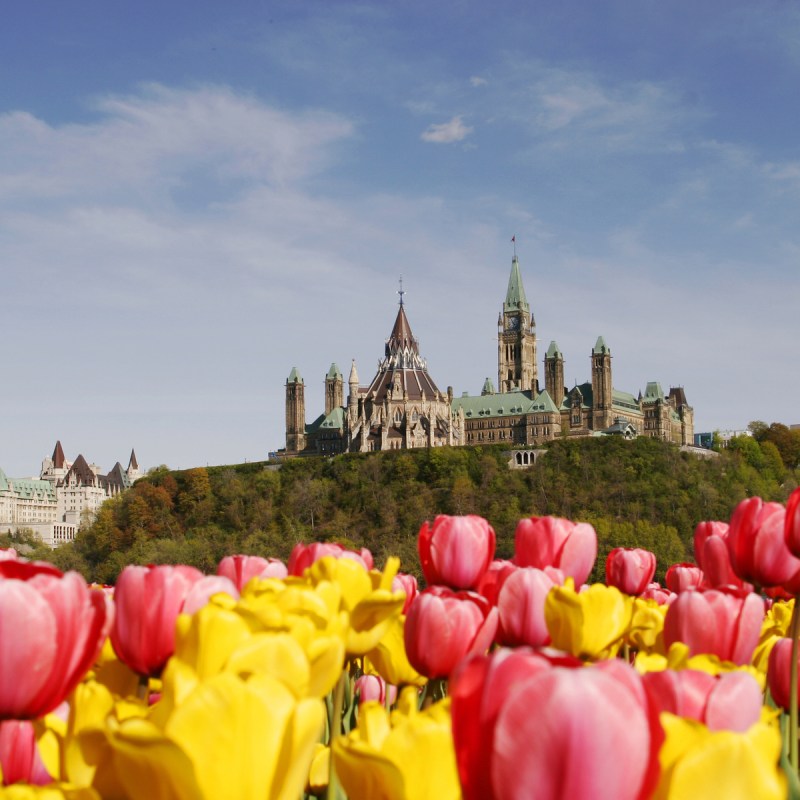
Every spring, Ottawa residents are itching for a warm sun and mild days. It’s not just that we’re anxious to put the long winter behind us; it’s because we are a city obsessed with tulips!
Videos by TravelAwaits
More than a million tulips will bloom across Ottawa (Canada’s capital) and nearby Gatineau, Quebec, as part of the Canadian Tulip Festival — often known locally as the Ottawa Tulip Fest. To say that Ottawa is transformed by these tulips would be an understatement. As someone who lives here, I think that we’re pretty proud of our city year-round. We’re a good looking capital! But come spring, there is spectacular color everywhere and the result is simply breathtaking.
The Canadian Tulip Festival (running from May 13–23, 2022), is the world’s largest tulip festival. In peak times, nearly 650,000 people would visit the blooms in a given year. These visitors don’t come simply to admire the gorgeous flower beds but also to enjoy other special activities that are offered as part of the festival. In past years, there have been concerts, lectures, children’s activities, special exhibits for art, culture, and history, and much more.
This year marks the 70th anniversary of the Canadian Tulip Festival. My neighbors and I are looking forward to extended viewing hours, outdoor movie nights, and a new blacklight art installation beside one of the biggest flower beds. But most of all, we’re eager to celebrate the origins of the festival, which commemorate an incredible war story.

How Did The Canadian Tulip Festival Originate
The origins of the Canadian Tulip Festival date back to WWII. Princess Juliana, heir to the Dutch throne, was evacuated to the United Kingdom with her family. However, even London couldn’t assure her safety, as the city was under bombardment. After a short stay, she and her children moved on and relocated to Canada. They settled in Ottawa and Juliana endured herself to local residents by living just like a local would and taking care of her own shopping.
In January 1943, Princess Juliana’s third child, Princess Margriet, was born in Ottawa’s Civic Hospital. The Canadian governor general declared her hospital rooms to be extraterritorial so the baby would have sole Dutch citizenship. As such, Princess Margriet was included in her country’s line of succession. She became the first European royal to be born in North America and her birth was greeted with incredible fanfare across Canada.
The already warm relationship between Canada and the Netherlands deepend even further towards the end of the war, as Canadian troops played a significant role in liberating the Dutch from occupation.
When Princess Juliana and her young family safely returned to the Netherlands after several years of exile, the bonds of friendship held fast. In 1945, the Dutch government sent 100,000 tulip bulbs to Canada to express their gratitude. Princess Juliana followed suit, donating an additional 20,500 bulbs the next year. From these early gifts, the origins of the Canadian Tulip Festival were born. The Dutch government has sent the gift of tulip bulbs to Canada every year since.
The festival owes a debt of thanks to Ottawa photographer Malak Karsh. Together with his brother Yousuf, the Karshes were two of the most prominent photographers in the world. Malak was famous for his nature scenes while Yousuf was an acclaimed portrait photographer. Malak’s interest in the tulips can be tracked back to 1949, when he photographed the blooming bulbs gifted by then Queen Juliana. In 1952, Malak suggested the idea of an annual festival to the Ottawa Board of Trade and the event officially began. He was the honorary president of the Canadian Tulip Festival until his death in 2001.

How To Visit The Canadian Tulip Festival
The festival’s in-person events take place primarily in Ottawa and across the river in Gatineau, Quebec. Ottawa is located in southeastern Ontario, about 4 hours from Toronto and 2 hours from Montreal. The American border is about an hour away, connecting the community of Cornwall with upstate New York. Ottawa is easy to access via car, bus, train, and plane.
While in Ottawa, festival sites and flower beds are within walking distance of each other — but sometimes those walks are on the long side. Public transit will cut down your commuting time significantly but there’s an even more convenient option: The Tulip Trolly! This shuttle bus makes getting around to the different sites a breeze. You can see ticketing information and shuttles here.
There is no admission fee for the festival nor any cost associated with visiting the tulip beds. Most activities are free as well. However, some special events (like guided tours) have a small fee and there are the usual travel expenditures (like snacks, drinks, and souvenirs).
Visitors looking to stay downtown (where many of the flower beds are located) will want to book in advance. The Westin, the Lord Elgin, and the Fairmont Chateau Laurier are three of the most popular and well-situated hotel choices. Photography fans will want to note that Malak’s brother Yousuf once lived in the Chateau Laurier and there is an excellent display of his famous portraits in the lobby, as well as a statue commemorating his life and art outside.
Another strong choice is the Hilton Garden Inn. Also located downtown, it’s a few blocks away from the other recommended hotels, but still in the heart of the action. And there is a subtle tulip theme throughout the property. Plus, their in-house restaurant is called Tulip! Cute name aside, it has some serious culinary chops and is one of my favorite places to eat in Ottawa.
Visitors who can’t make it to Ottawa will be happy to learn that there’s a virtual component to the festival as well.

Where To See The Blooms
Your first stop is Dow’s Lake, a neighborhood southwest of downtown along the Rideau Canal. It’s home to Commissioner’s Park, where 300,000 tulips bloom. Visitors often wonder if it’s the same bulbs that are blooming year after year and the short answer is no — for the most part. While some bulbs are replanted, most are dug up and donated to non-profits and schools and some are composted. A huge team of gardeners tend to these beds, preparing them in the fall and keeping them looking fresh in spring.
While in Commissioner’s Park, keep an eye out for the Queen Juliana Gift Bed. This is the primary flower bed where the bulbs gifted annually by the Netherlands are planted. The others are at the Civic Hospital, where Princess Margriet was born, and St. Andrew’s Presbyterian Church, where she was baptized. The church recieves 100 bulbs from the Dutch embassy each year. The remainder of the bulbs you see are purchased primarily by the Canadian government. Another point of interest in Commissioner’s Park is a statue entitled The Man With Two Hats. It celebrates the relationship between the two countries — and it has a twin in town of Apeldoorn in the Netherlands. (Princess Margriet was on hand to unveil both of them).
Following the Rideau Canal towards downtown, you’ll see lovely flower beds alongside the water and Queen Elizabeth Driveway. If you’re a runner, this is where you’ll want to get in your training miles. There are gorgeous tulip beds on the lawn of Parliament Hill, where the Canadian government sits. Looking across the river to Gatineau, you’ll see even more tulips in the distance, including a large bed beside the Canadian Museum of History. Known as “Malak’s Bed,” these flowers honor Malak Karsh. They allow the viewer to take in a scene that inspired one of Malak’s most famous photographs, with tulips in the foreground and the Canadian Parliment in the background.
While all these tulip beds are beautiful, my favorite spot to enjoy the blooms is in residential neighborhoods. Ottawa residents are justifiably proud of how their city transforms under the gorgeous blooms each year and we’re keen to be a part of it. Feel free to stroll and explore and you might just find your own personal favorite spot!
